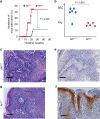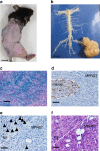NF1 heterozygosity fosters de novo tumorigenesis but impairs malignant transformation
- PMID: 30479396
- PMCID: PMC6258697
- DOI: 10.1038/s41467-018-07452-y
NF1 heterozygosity fosters de novo tumorigenesis but impairs malignant transformation
Abstract
Neurofibromatosis type 1 (NF1) is an autosomal genetic disorder. Patients with NF1 are associated with mono-allelic loss of the tumor suppressor gene NF1 in their germline, which predisposes them to develop a wide array of benign lesions. Intriguingly, recent sequencing efforts revealed that the NF1 gene is frequently mutated in multiple malignant tumors not typically associated with NF1 patients, suggesting that NF1 heterozygosity is refractory to at least some cancer types. In two orthogonal mouse models representing NF1- and non-NF1-related tumors, we discover that an Nf1+/- microenvironment accelerates the formation of benign tumors but impairs further progression to malignancy. Analysis of benign and malignant tumors commonly associated with NF1 patients, as well as those with high NF1 gene mutation frequency, reveals an antagonistic role for NF1 heterozygosity in tumor initiation and malignant transformation and helps to reconciliate the role of the NF1 gene in both NF1 and non-NF1 patient contexts.
Conflict of interest statement
The authors declare no competing interests.
Figures







References
-
- Friedman, J. M. in GeneReviews(R) (eds. Pagon, R. A., et al.) (University of Washington, Seattle, WA,1993). - PubMed
Publication types
MeSH terms
Substances
Grants and funding
LinkOut - more resources
Full Text Sources
Molecular Biology Databases
Research Materials
Miscellaneous

